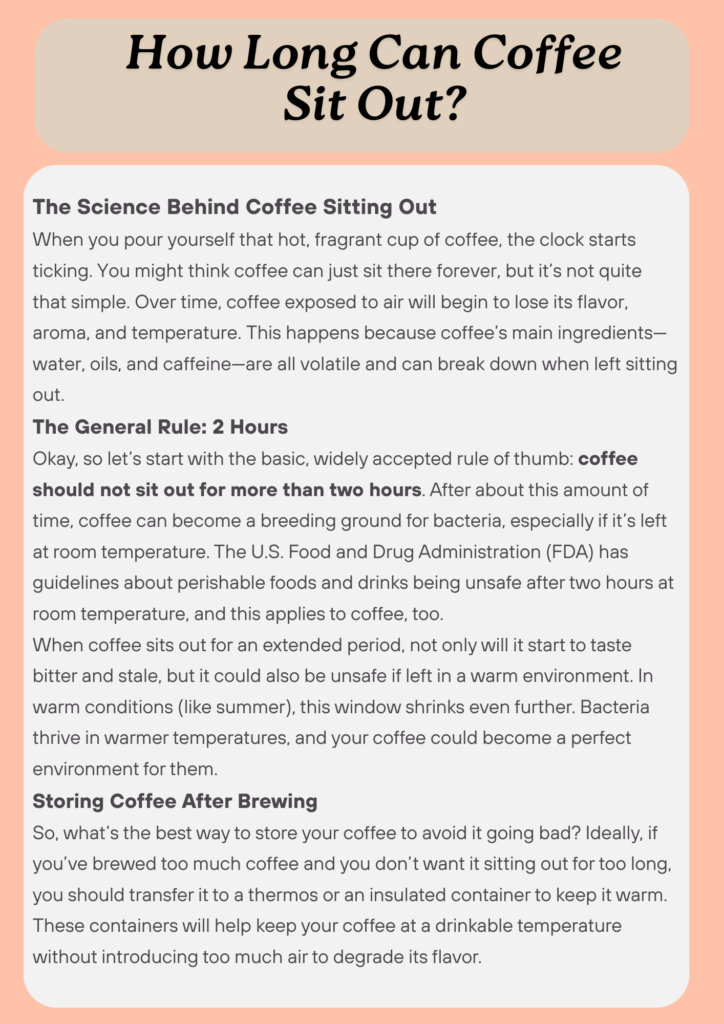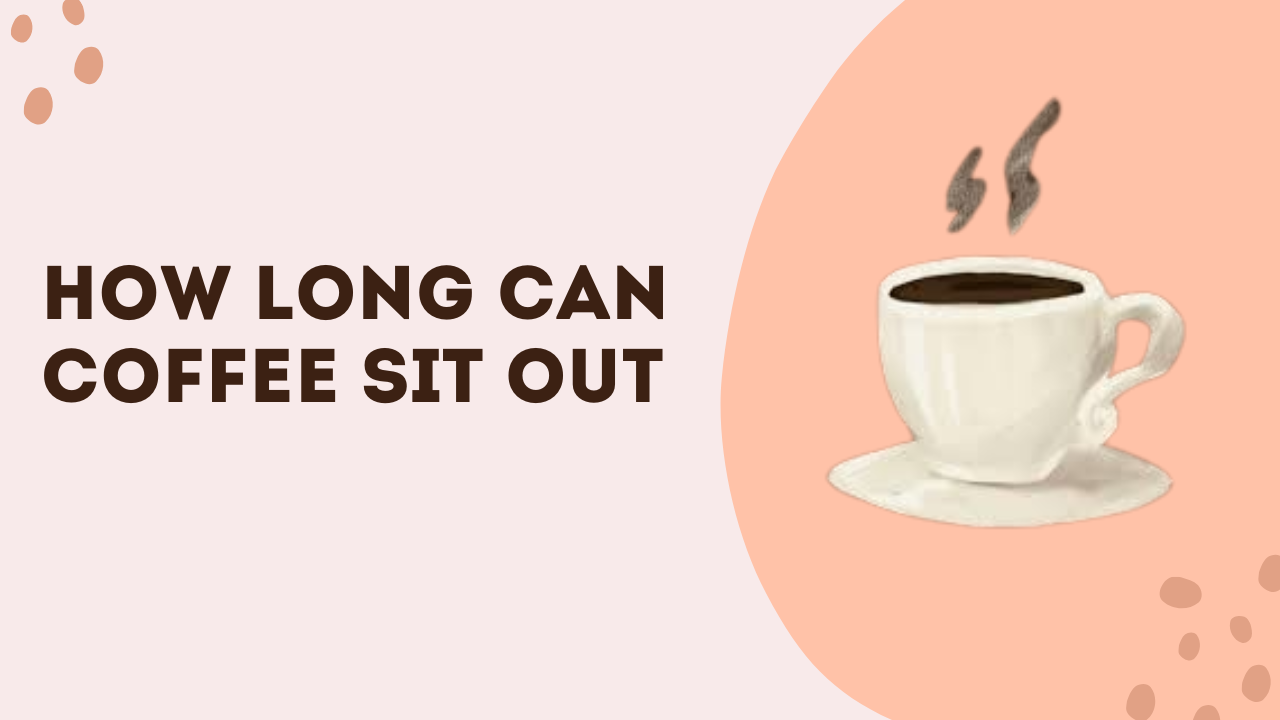Coffee lovers, we’ve all been there. You brew a fresh cup of coffee, sit down to enjoy it, and then, oops, you get distracted. Maybe you’re answering emails, chatting with friends, or just lost in your thoughts. Before you know it, your once-steaming cup of coffee has gone lukewarm. But wait—how long can coffee actually sit out before it’s too risky to drink? It’s one of those questions that gets tossed around a lot, but the truth isn’t always clear. In this article, we’re going to break it down for you and answer the burning question once and for all: How long can coffee sit out, and is it still safe to drink after a while? Let’s dive in!
The Science Behind Coffee Sitting Out
So, let’s get into the nitty-gritty. When you pour yourself that hot, fragrant cup of coffee, the clock starts ticking. You might think coffee can just sit there forever, but it’s not quite that simple. Over time, coffee exposed to air will begin to lose its flavor, aroma, and temperature. This happens because coffee’s main ingredients—water, oils, and caffeine—are all volatile and can break down when left sitting out.
Now, how long exactly does it take for coffee to go bad? Well, it depends on a few factors like temperature, how much time passes, and how the coffee is stored. Let’s break these down a bit more.
The General Rule: 2 Hours
Okay, so let’s start with the basic, widely accepted rule of thumb: coffee should not sit out for more than two hours. After about this amount of time, coffee can become a breeding ground for bacteria, especially if it’s left at room temperature. The U.S. Food and Drug Administration (FDA) has guidelines about perishable foods and drinks being unsafe after two hours at room temperature, and this applies to coffee, too.
When coffee sits out for an extended period, not only will it start to taste bitter and stale, but it could also be unsafe if left in a warm environment. In warm conditions (like summer), this window shrinks even further. Bacteria thrive in warmer temperatures, and your coffee could become a perfect environment for them.
But here’s where things get a little tricky—just because your coffee sits out for more than two hours doesn’t mean it’s immediately dangerous. However, the risk increases the longer it sits.

What Happens After Two Hours?
After the two-hour mark, you might start to notice a few things happening to your coffee. First, the temperature will likely drop significantly, turning it into a lukewarm or room temperature brew. The bitterness of the coffee will also become more pronounced. Freshly brewed coffee is usually rich, smooth, and flavorful, but when it sits around for too long, it oxidizes, and the compounds in the coffee begin to break down. This is why old coffee can taste a bit…off.
At room temperature, coffee’s flavor will begin to degrade, and not just because it’s cold—because it’s also losing its natural oils and aromatic compounds. If you let it sit for even longer, say four or more hours, the coffee’s taste and aroma will just keep getting worse. That’s when it becomes really unpleasant to drink.
Storing Coffee After Brewing
So, what’s the best way to store your coffee to avoid it going bad? Ideally, if you’ve brewed too much coffee and you don’t want it sitting out for too long, you should transfer it to a thermos or an insulated container to keep it warm. These containers will help keep your coffee at a drinkable temperature without introducing too much air to degrade its flavor.
If you’re not planning to drink the coffee for a while, refrigerating it is another option. Yes, you can refrigerate brewed coffee, and it will last a few days, though the flavor will continue to change, and it may taste a little flat. You can also reheat your refrigerated coffee, but it’s important to note that reheating will alter its flavor even further.
What About Coffee Creamers?
Now, let’s talk about one common addition that people often forget when it comes to how long coffee can sit out: creamers. If your coffee has dairy or even non-dairy creamers, the situation becomes more complicated. Dairy, especially, can spoil quickly at room temperature, and if your coffee contains milk or cream, it should not be left out for more than an hour. The same goes for creamers that need to be refrigerated—if you add those to your coffee and leave it sitting out for too long, you could risk consuming something that’s gone bad and might upset your stomach.
How to Tell if Your Coffee Has Gone Bad
You might be thinking, “Okay, but how can I tell if my coffee is still okay to drink?” Well, aside from the obvious taste test (and let’s face it, it’s a risky one), here are some signs to watch out for:
- Smell: If your coffee smells sour or rancid, that’s a good sign it’s gone bad.
- Taste: As mentioned earlier, after it sits out too long, coffee will taste bitter and stale. If it tastes off in any way, toss it.
- Look: If you notice any mold or unusual film on the surface, that’s a clear indicator that your coffee is no longer safe to drink.
The Bottom Line
When it comes down to it, coffee can sit out for a few hours, but the longer it sits, the worse it gets in both taste and safety. For the best flavor, it’s recommended to drink your coffee within the first two hours. If you plan on saving some for later, store it in a thermos, or if you don’t mind the change in flavor, pop it in the fridge. And always be cautious with creamers or milk in your coffee—dairy can spoil much quicker.
So, next time you’re sipping that cup of coffee and you leave it on the counter while you get caught up in a conversation or dive into work, just remember: two hours is your safe window. After that, it might be better to brew a fresh cup. Trust us, your taste buds (and your stomach) will thank you!
